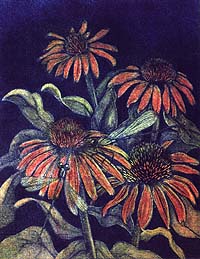I have been attracted to the
variety and versatility of printmaking for many
years. During that time I have experimented with many
techniques, some quite bizarre, like sandblasting
resist treated plate glass, using caustic soda on
wood and linoleum and even an oxy-acetylene torch on
zinc.
 However, the rich velvety black one can achieve with the
mezzotint rocker has become my preferred method of printmaking. It requires
no chemicals- just "elbow grease." While I still sometimes
rock over the entire surface of the copper plate and then scrape and
burnish in the traditional way, I have, for several years, used the
rocker as a tool to create the image. At first it seemed a clumsy approach
but gradually I became adept in manipulating it with precision. This
has added a whole new dimension to my work.
However, the rich velvety black one can achieve with the
mezzotint rocker has become my preferred method of printmaking. It requires
no chemicals- just "elbow grease." While I still sometimes
rock over the entire surface of the copper plate and then scrape and
burnish in the traditional way, I have, for several years, used the
rocker as a tool to create the image. At first it seemed a clumsy approach
but gradually I became adept in manipulating it with precision. This
has added a whole new dimension to my work.
With this technique I created the
mezzotint " Silent Witness". After making a
few prints it occurred to me that I could develop the
image further by additional rocking, burnishing, dry
point and masking into different, though related
images. In this manner a series of prints was created
as each new idea was realised and proofed.
I make 5 or 6 prints before moving
on to further evolve an idea. " Silent
Witness," is number eleven of a series of
twelve. Sometimes a series is numerically larger. But
often after only a few metamorphoses I've fully
explored the primary image and 'retire' the plate. I
find this an exciting process and work on the plate
can be resumed after lengthy intervals when and if
newly inspired!
 After reading about Jean Christophe LeBlon's attempts circa
1719 to create 3 plate colour mezzotints I visited the print departments
of the
After reading about Jean Christophe LeBlon's attempts circa
1719 to create 3 plate colour mezzotints I visited the print departments
of the
Victoria and Albert Museum, the
British Museum and the National Gallery of Art in
Washington D.C. to see his work. I was shown some
large and rather disappointing portraits.
Nevertheless, I decided to try the technique.
It has been an ongoing challenge. I
usually create a master mezzotint plate, which I
offset onto two or more other plates of the same
size. Then I decide where and how to put the other
colours. Some of them must overlap others to produce
secondary hues. I use the rocker selectively and with
differing density to vary the intensity of the
colours. Registration is a problem especially with
the larger plates. "The Dragon Flies' was rocked
and dry-pointed.
Colour mezzotints are very labour
intensive and seductive but, after doing nearly 50 of
them, I still prefer black and white.
A. David Crown, M.D. I.M.S.
4005 N.W 69th St.
Gainesville Florida, 32606
U.S.A.
davidcrown@juno.com
David is the founder of the International Mezzotint
Society
 The information resource for printmakers
The information resource for printmakers
 The information resource for printmakers
The information resource for printmakers